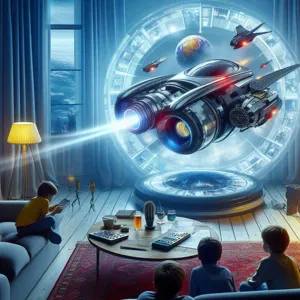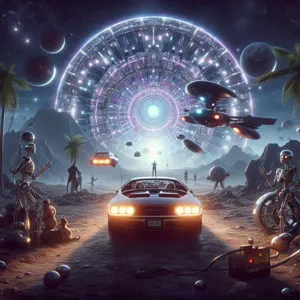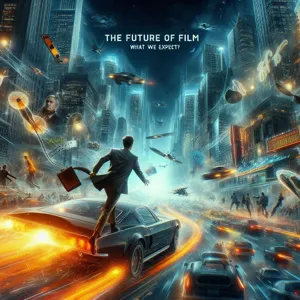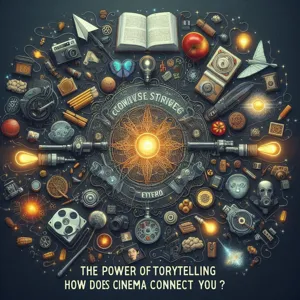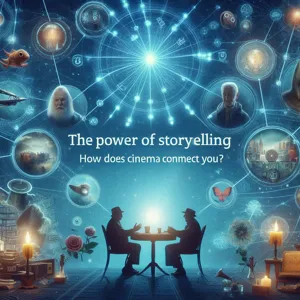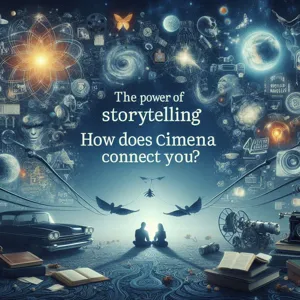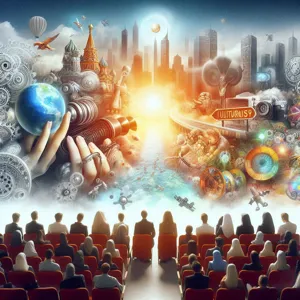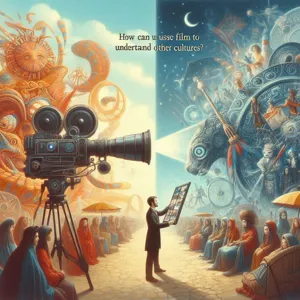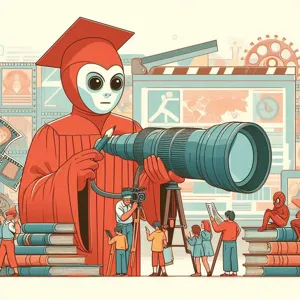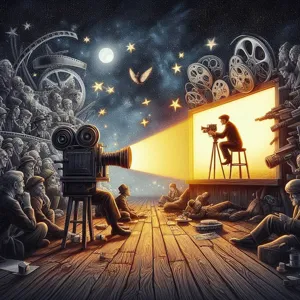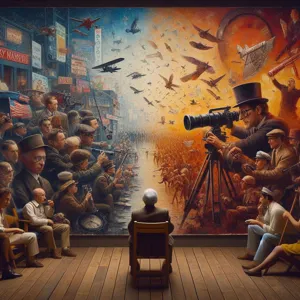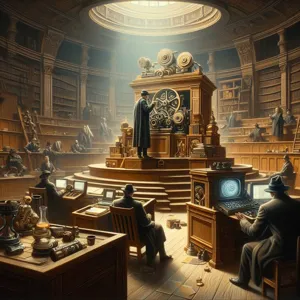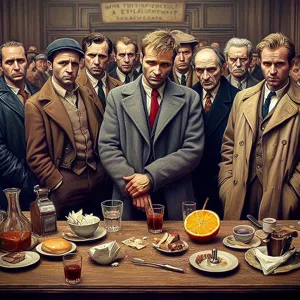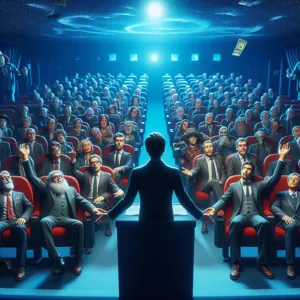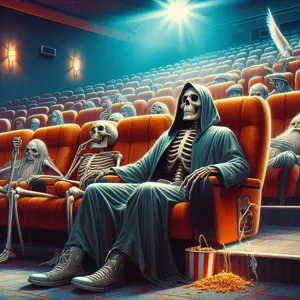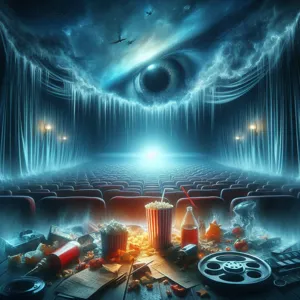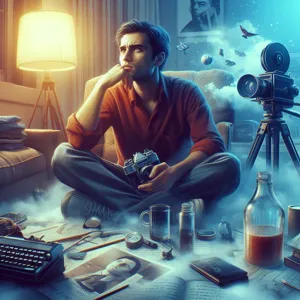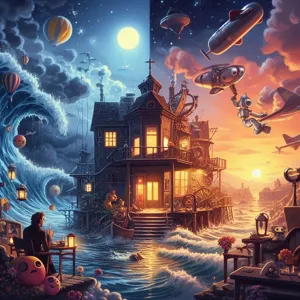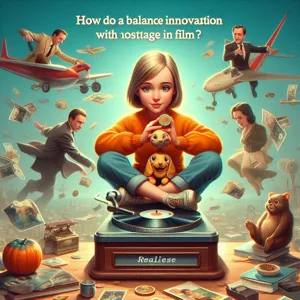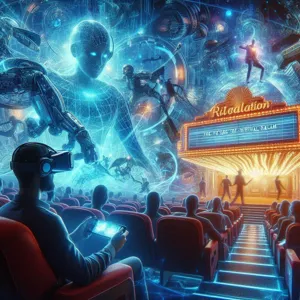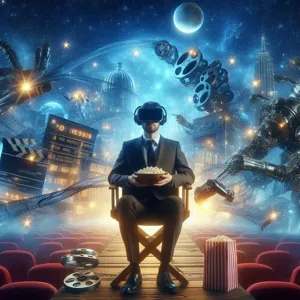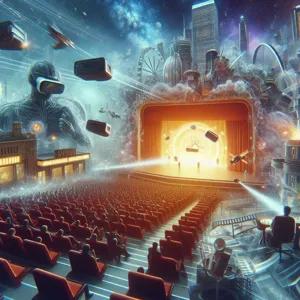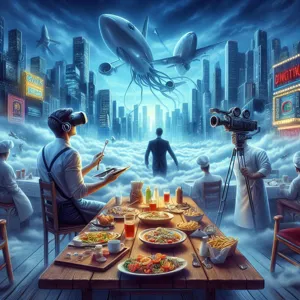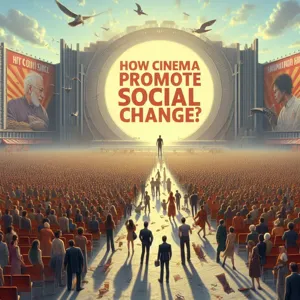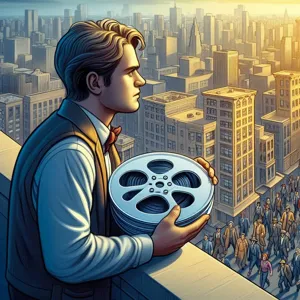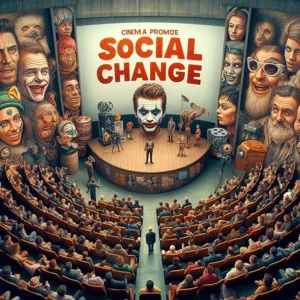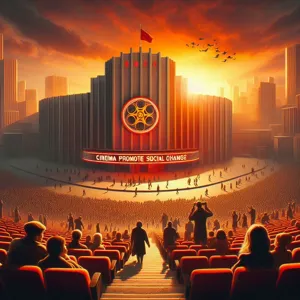Cinema has long served as a powerful lens through which we can examine the complexities of the human experience, offering a reflection of society’s values, struggles, and triumphs.
As the world continues to evolve at a dizzying pace—shaped by technological advancements, cultural shifts, and social movements—the film industry remains at the forefront, adapting and responding to the zeitgeist in profound ways. In “Reel Reflections: How Cinema Mirrors a Changing World,” we delve into the intricate relationship between film and reality, exploring how cinema not only captures the essence of contemporary issues but also influences public perception and cultural dialogue. From poignant narratives that challenge societal norms to groundbreaking storytelling that amplifies underrepresented voices, this blog post invites you on a journey through the celluloid landscape to uncover how filmmakers reflect, critique, and ultimately shape the world we live in. Join us as we explore the transformative power of cinema and its role as both a mirror and a catalyst for change in an ever-evolving society.
1. Introduction: The Power of Cinema as a Reflection of Society
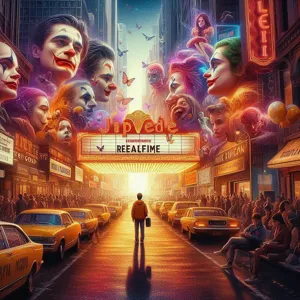
Cinema has long been heralded as a powerful medium, capable of capturing the essence of human experience and mirroring the complexities of society. From its inception, film has provided a unique lens through which audiences can explore the myriad facets of life, culture, and social dynamics. The flickering images on screen are not merely entertainment; they are reflections of our hopes, fears, struggles, and triumphs.
As society evolves, so too does the narrative of cinema. Whether through the rise of independent films, the emergence of diverse voices, or the exploration of pressing contemporary issues, films serve as a barometer for the zeitgeist, capturing the mood and ethos of the times. They challenge societal norms, provoke thought, and inspire change, making them an integral part of cultural discourse.
In this blog post, we will delve into how cinema not only reflects the world around us but also influences it. We’ll explore key films that have shaped and mirrored societal changes, highlighting their thematic significance and the dialogues they ignite. By examining the interplay between film and the societal context in which it is created, we can gain a deeper understanding of the power of cinema as a catalyst for reflection and transformation. Join us as we embark on this cinematic journey, exploring how the silver screen continually mirrors a changing world.
2. Historical Context: Cinema’s Role in Shaping Cultural Narratives
Cinema has always served as a powerful lens through which societies can examine their past, confront their present, and envision their future. From the very inception of film as an art form, it has played a pivotal role in shaping cultural narratives, often reflecting the prevailing social attitudes, political climates, and economic realities of its time. As we delve into the historical context of cinema, it becomes evident that films are not merely entertainment; they are a mirror, reflecting the complexities of human experience and societal change.
In the early 20th century, silent films often echoed the struggles and aspirations of the working class, offering a form of escapism amidst the harsh realities of industrialization. As we transitioned into the Golden Age of Hollywood, films began to craft more intricate narratives, grappling with issues such as war, race, and gender. Classics like “Gone with the Wind” and “Casablanca” captured the zeitgeist of their eras, intertwining personal stories with broader historical events. These films did not just entertain; they influenced public perception and dialogue, shaping how audiences understood critical issues of their time.
As the world moved through the tumultuous decades of the 1960s and 1970s, cinema became a vital tool for social commentary. Filmmakers like Martin Scorsese, Spike Lee, and Francis Ford Coppola used their platforms to challenge the status quo, addressing themes of civil rights, counterculture, and the disillusionment of the American Dream. Their works encouraged audiences to confront uncomfortable truths and engage in meaningful conversations about societal norms.
In more recent years, the rise of digital technology and independent filmmaking has democratized the storytelling process, allowing diverse voices to emerge and share their narratives. Films like “Black Panther” and “Moonlight” not only entertained but also provided representations that were historically absent from mainstream cinema, reshaping cultural narratives around race, identity, and sexuality. These stories resonate deeply with audiences, fostering empathy and understanding in a world often divided by differences.
As we look to the future, the role of cinema in shaping cultural narratives remains as crucial as ever. With the ongoing evolution of global issues such as climate change, social justice, and technological advancement, filmmakers will undoubtedly continue to reflect and respond to the world around them. By engaging with these narratives, audiences can better understand their place in the tapestry of human experience, making cinema a transformative vehicle for change and reflection.
3. The Evolution of Film Genres and Their Societal Impact
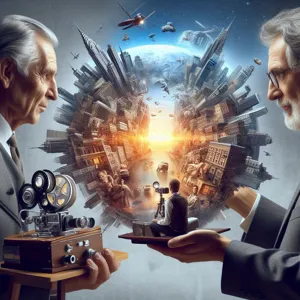
The evolution of film genres offers a fascinating lens through which we can examine the shifting tides of society. From the silent films of the early 20th century to the sprawling blockbusters of today, each genre not only entertains but also reflects the cultural, political, and social dynamics of its time.
In the 1930s and 1940s, for instance, the rise of film noir encapsulated the disillusionment and moral ambiguity of the post-war era. Dark alleys, femme fatales, and anti-heroes mirrored the anxieties of a society grappling with the fallout of the Great Depression and World War II. As America began to confront its own identity in the 1960s and 1970s, we saw a surge in the popularity of countercultural films that challenged the status quo—think “Easy Rider” and “The Graduate.” These films not only entertained but sparked dialogues about youth rebellion, personal freedom, and societal change.
As we moved into the 21st century, the rise of superhero films and dystopian narratives mirrored global concerns around security, identity, and environmental crises. The success of franchises like the Marvel Cinematic Universe illustrates a collective yearning for hope and heroism in times of uncertainty, while films like “The Hunger Games” and “Mad Max: Fury Road” comment on social stratification and the consequences of unchecked power.
Furthermore, the emergence of niche genres—such as LGBTQ+ cinema and films focusing on racial narratives—reflects an increasing demand for representation and inclusivity. These films challenge stereotypes, elevate marginalized voices, and foster empathy, contributing to broader societal dialogues.
In essence, the evolution of film genres is a barometer of our times, revealing insights into our collective psyche and the pressing issues we face. As we continue to navigate a rapidly changing world, cinema remains a vital mirror, reflecting our hopes, fears, and the complex tapestry of human experience.
4. How Classic Films Addressed Social Issues of Their Time
Classic films have long served as powerful mirrors reflecting the societal issues and cultural dilemmas of their eras. From the gritty realism of 1930s film noir to the sweeping epics of the 1950s, these cinematic masterpieces didn’t just entertain; they sparked conversations and challenged audiences to confront uncomfortable truths.
Take, for instance, “To Kill a Mockingbird” (1962), a film that bravely tackled racism and injustice in the Deep South through the eyes of a child. Its poignant narrative not only highlighted the systemic failures of the legal system but also cultivated empathy in its viewers, urging society to reflect on its prejudices. Similarly, “The Grapes of Wrath” (1940) exposed the harsh realities of the Great Depression, capturing the plight of displaced families and the struggle for dignity amidst economic despair. Through its powerful storytelling, the film ignited conversations about poverty and the resilience of the human spirit.
As societal norms shifted, so too did the themes explored in film. The 1960s and 70s brought forth a wave of films that addressed issues like feminism and war, as seen in “The Graduate” (1967) and “Apocalypse Now” (1979). These films not only entertained but also provoked critical thought, challenging audiences to examine their own beliefs and the world around them.
In revisiting these classic films, we gain insights into the societal landscapes of the past, understanding how they influenced public opinion and policy. The conversations they sparked continue to resonate today, reminding us that cinema is not merely a reflection of our world but a catalyst for change. As we explore the rich tapestry of classic films, we can appreciate how they served as both art and activism, shaping and mirroring the evolving narrative of society.
5. The Rise of Independent Cinema: Voices from the Margins
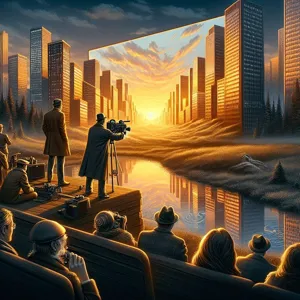
The rise of independent cinema has ushered in a vibrant tapestry of voices that reflect the complexities and nuances of our ever-evolving society. No longer confined to the margins of the film industry, independent filmmakers are boldly stepping into the spotlight, offering fresh narratives that challenge dominant cultural perspectives and illuminate experiences often overlooked by mainstream media.
In an age where streaming platforms and digital distribution have democratized access to filmmaking, we are witnessing an explosion of diverse stories that resonate with audiences on a personal level. From intimate character studies to sweeping tales of resilience, these films delve into themes of identity, social justice, and community, often drawing inspiration from the filmmakers’ own lived experiences.
Consider the poignant storytelling of filmmakers like Barry Jenkins, whose groundbreaking film “Moonlight” not only earned critical acclaim but also won the Academy Award for Best Picture, shining a light on the struggles of a young Black man grappling with his sexuality in a world fraught with prejudice. Similarly, films like “The Farewell” by Lulu Wang and “Lady Bird” by Greta Gerwig showcase the rich tapestry of cultural heritage and familial dynamics, offering audiences a glimpse into the complexities of their respective worlds.
Independent cinema thrives on its ability to push boundaries and provoke thought. It invites us to question societal norms and explore the stories of those who often remain unheard. With each new release, independent filmmakers are not only enriching the cinematic landscape but also fostering a greater understanding of the multifaceted human experience. As audiences increasingly seek authenticity and representation, the rise of independent cinema serves as a powerful reminder that the most compelling stories often come from the margins, reflecting the rich diversity of our global community.
In this way, independent films not only entertain but also empower, encouraging viewers to engage with the world around them in meaningful ways. As we continue to embrace these voices from the margins, we pave the way for a more inclusive and representative cinematic future.
6. Representation and Diversity in Film: Progress and Challenges
Representation and diversity in film have become central topics of discussion in recent years, reflecting broader societal conversations about inclusivity and equity. While there has been notable progress in the portrayal of marginalized groups on screen, the journey is far from complete. The strides made in recent years—such as the increased visibility of women, people of color, the LGBTQ+ community, and individuals with disabilities—underscore a growing recognition of the importance of diverse narratives. Films like “Black Panther” and “Crazy Rich Asians” have shattered box office records, demonstrating that audiences crave stories that resonate with their own experiences and backgrounds.
However, despite these advancements, challenges persist. Often, when diversity is showcased, it can be tokenistic rather than authentic, reducing complex characters to mere symbols of representation rather than fully fleshed-out individuals. Additionally, behind-the-scenes roles—such as directors, producers, and writers—remain disproportionately dominated by a homogenous group, limiting the perspectives that shape the stories being told. This gap highlights the need for ongoing advocacy and support for diverse talent both in front of and behind the camera.
The film industry is at a crucial crossroads, grappling with the dual responsibility of reflecting the rich tapestry of human experience while also pushing the boundaries of storytelling. As audiences become more vocal about representation, filmmakers are challenged to rise to the occasion and create works that are not only entertaining but also transformative. The journey toward true diversity in cinema is ongoing, and it serves as a mirror to a world that is itself evolving—one that demands authenticity, nuance, and depth in the narratives we choose to share.
7. The Role of Documentary Films in Social Awareness
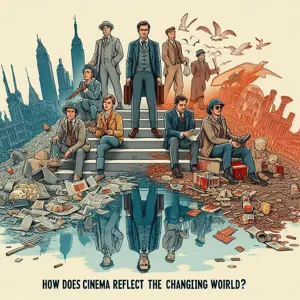
Documentary films have long served as a powerful lens through which audiences can explore the multifaceted issues facing our society. Unlike traditional narratives that often prioritize entertainment over education, documentaries aim to inform, engage, and evoke empathy. In an era where misinformation can spread like wildfire, these films are not just a source of information; they are vital instruments of social awareness and change.
Through compelling storytelling, documentaries bring to light the stories of marginalized communities, environmental crises, and political injustices. They present real-life accounts that resonate with viewers, prompting them to reflect on their own lives and the world around them. For instance, films like “13th” examine the systemic racism embedded in the United States’ criminal justice system, while “Our Planet” offers a stark reminder of the urgent need for environmental conservation. Each frame and interview invites audiences to confront uncomfortable truths and consider their role in fostering a more just and equitable world.
Moreover, the rise of digital platforms has made documentaries more accessible than ever, allowing voices from different corners of the globe to be heard. This democratization of storytelling not only broadens our understanding of global issues but also empowers viewers to advocate for change in their own communities. Documentaries often include calls to action, encouraging audiences to participate in movements, support local initiatives, or simply engage in meaningful conversations about pressing social issues.
In this way, documentary films not only reflect the changing world but actively shape it. They challenge narratives, inspire dialogue, and ignite passion for social justice, proving that cinema can be a force for transformation. As viewers, we are invited to not just watch, but to engage, reflect, and ultimately act—making documentary films an essential part of our collective journey towards greater awareness and understanding.
8. The Influence of Technology on Filmmaking and Storytelling
The influence of technology on filmmaking and storytelling is nothing short of revolutionary. As we delve into the heart of modern cinema, we witness a remarkable transformation driven by advancements in digital technology, visual effects, and innovative storytelling tools. Gone are the days when filmmakers were constrained by the limitations of traditional film; today, they harness cutting-edge technology to create immersive experiences that captivate audiences like never before.
From the rise of CGI (computer-generated imagery) to the accessibility of high-quality cameras and editing software, technology has democratized filmmaking, enabling a new generation of creators to tell their stories. Independent filmmakers, once sidelined by budget constraints, can now produce feature-length films with a fraction of the cost thanks to affordable equipment and user-friendly editing programs. This shift has led to a surge in diverse narratives that reflect the richness of human experience, often highlighting voices that have been historically marginalized.
Moreover, technology has redefined how stories are told. Interactive storytelling platforms and virtual reality experiences allow audiences to engage with narratives in ways that were previously unimaginable. Viewers are no longer passive observers; they can now step into the shoes of characters, make choices, and shape the outcome of a story. This evolution not only enhances emotional connection but also challenges traditional storytelling conventions, offering new dimensions of engagement.
Streaming services have further transformed the cinematic landscape, providing filmmakers with unprecedented access to global audiences. With the click of a button, viewers can explore a vast array of films from different cultures and backgrounds, fostering a greater understanding of diverse perspectives. As a result, cinema is not just a reflection of societal values; it is also a catalyst for change, sparking conversations about pressing issues and inspiring action.
In this era of rapid technological advancement, the relationship between film and society is more intertwined than ever. Filmmakers are leveraging technology not just as a tool for creation, but as a means of commentary, exploring themes like artificial intelligence, social media, and the impact of technology on human relationships. As we watch these stories unfold on the screen, we are reminded that cinema is not just a mirror reflecting our world; it is a powerful vehicle for examining the complexities of our evolving reality. In this dynamic landscape, the influence of technology continues to shape not only how stories are told but also the very narratives that define our collective experience.
9. Global Perspectives: How Different Cultures Use Cinema to Reflect Change
Cinema has long served as a powerful medium for storytelling, but its role as a mirror reflecting societal change varies significantly across different cultures. In many parts of the world, filmmakers harness the visual language of film to comment on pressing social issues, cultural shifts, and political transformations.
In Hollywood, for instance, the rise of diverse narratives has brought to light the experiences of underrepresented communities, tackling themes such as race, gender, and identity. Films like “Black Panther” and “Parasite” not only entertain but also provoke discussions about systemic inequality and the complexities of identity in an interconnected world. These narratives resonate globally, inspiring similar movements in other regions.
In contrast, Bollywood, with its vibrant storytelling and musical elements, often addresses social issues through a lens of hope and resilience. Films like “Pad Man,” which tackles menstrual hygiene, and “Article 15,” which confronts caste discrimination, serve to educate audiences while sparking societal conversations. The unique blend of entertainment and social commentary makes Indian cinema a powerful vehicle for change, encouraging audiences to reflect on their own lives and societal norms.
Meanwhile, in countries like Iran, filmmakers navigate strict censorship and political constraints to convey poignant messages. Directors such as Asghar Farhadi masterfully weave narratives that critique societal issues under the guise of personal stories, subtly challenging the status quo. His acclaimed film “A Separation” explores themes of morality and societal pressure, compelling audiences to confront the complexities of human relationships amidst political unrest.
In regions struggling with conflict, such as the Middle East or parts of Africa, cinema becomes a means of resilience and healing. Filmmakers like Timo von Gunten, in his film “The Last Dance,” utilize the medium to document their communities’ struggles and triumphs, fostering a sense of unity and hope among viewers. These films often serve as a reflection of the harsh realities faced by individuals, while simultaneously offering a platform for voices that might otherwise remain unheard.
Through these diverse lenses, cinema not only entertains but also educates, provokes thought, and inspires change. The way different cultures utilize film to reflect their evolving realities underscores the power of this art form to transcend borders, fostering a global dialogue about the challenges and triumphs of the human experience. As we continue to explore these varied perspectives, we gain a deeper understanding of how cinema can illuminate the complexities of our shared world, inviting us to not only watch but to engage, reflect, and act.
10. The Impact of Streaming Services on Film Accessibility and Diversity
The rise of streaming services has fundamentally transformed the landscape of cinema, reshaping not only how we consume films but also who gets to tell their stories. Gone are the days when access to diverse films depended solely on geographic location or the whims of traditional distribution channels. With platforms like Netflix, Amazon Prime, Hulu, and Disney+, audiences now have a treasure trove of films at their fingertips, offering a rich tapestry of narratives that reflect a myriad of cultures, experiences, and perspectives.
Before the streaming revolution, independent filmmakers and underrepresented voices often struggled to find a platform for their work. However, the democratization of content distribution through streaming services has paved the way for an explosion of diversity in filmmaking. Audiences are now treated to a wider array of films focusing on different ethnicities, genders, and sexual orientations, showcasing stories that might have once been sidelined by major studios. This increased visibility not only enriches the cinematic landscape but also fosters a greater understanding and appreciation of cultural differences among viewers.
Furthermore, streaming platforms are not just passive distributors; they actively invest in original content that champions diverse narratives. The success of films like “Roma,” “The Half of It,” and “Minari” illustrates that there is a hungry audience for stories that reflect the complexities of the human experience beyond mainstream tropes. Additionally, these platforms often feature curated sections that highlight international films and documentaries, encouraging viewers to explore cinema from different parts of the world.
However, while streaming services have indeed made it easier for diverse voices to be heard, they also present new challenges. The sheer volume of available content can be overwhelming, making it difficult for audiences to discover hidden gems, especially those from lesser-known filmmakers. As viewers become accustomed to the convenience of streaming, there is a risk that niche films could become lost in the vast sea of content, leading to a homogenization of what gets widely viewed.
Ultimately, the impact of streaming services on film accessibility and diversity is profound. They have opened doors for a broader range of stories to be told and have empowered audiences to seek out and engage with content that resonates with their lives and experiences. As we continue to navigate this evolving cinematic landscape, it becomes essential for both creators and audiences to embrace the wealth of diverse narratives available, ensuring that every voice has a place in the ever-expanding world of film.
11. Case Study: Notable Films That Captured Cultural Shifts
Cinema has long served as a powerful lens through which we can examine the cultural zeitgeist of any given era. Certain films not only entertained audiences but also reflected the shifting values, social issues, and collective anxieties of their times. In this section, we will explore several notable films that stand as testaments to the dynamic interplay between cinema and the cultural landscape.
Take, for instance, **”Guess Who’s Coming to Dinner” (1967)**. Released during a time of heightened civil rights activism in the United States, this groundbreaking film tackled the then-controversial subject of interracial marriage. Through the lens of a liberal white couple grappling with their daughter’s engagement to a Black man, it opened a dialogue about race relations, challenging societal norms and encouraging audiences to reconsider their prejudices. Its impact was felt far beyond the silver screen, contributing to a gradual shift in public perceptions of race and love.
Another pivotal example is **”The Breakfast Club” (1985)**, which captured the complexities of teenage life in the 1980s. This iconic film brought together a diverse group of high school students, each representing different social cliques, and highlighted the shared struggles of adolescence. In doing so, it echoed the growing awareness of mental health issues and the importance of empathy and understanding across social divides—theme still relevant to today’s youth.
Fast forward to the 21st century, and we cannot overlook **”Black Panther” (2018)**, which not only shattered box office records but also elevated conversations around representation in Hollywood. By showcasing a predominantly Black cast in a major superhero film, it celebrated African culture while addressing themes of identity, power, and social justice. Its success was a clear indication of the shifting tides in the film industry, pushing for more diverse storytelling and paving the way for future filmmakers to explore untold narratives.
These films, among many others, serve as cultural touchstones that remind us of the power of cinema to reflect societal changes. By mirroring the world around us, they not only document history but also inspire dialogue and reflection on our values and beliefs. As we continue to navigate an ever-evolving cultural landscape, it is clear that cinema will remain a vital medium for examining and understanding the human experience.
12. The Future of Cinema: Trends and Predictions for a Changing World
As we stand on the cusp of a new era in filmmaking, the future of cinema is poised to evolve dramatically, shaped by shifting societal norms, technological advancements, and an ever-expanding global audience. The advent of streaming platforms has already transformed the landscape, democratizing access to films and allowing diverse voices to emerge from the shadows of traditional studios. This trend is expected to continue, with an increasing number of filmmakers opting for digital distribution channels that allow for greater creative freedom and audience engagement.
Virtual reality (VR) and augmented reality (AR) are also set to redefine the cinematic experience, offering immersive storytelling that invites viewers to step inside the narrative. Imagine donning a headset and finding yourself in the midst of a fantastical world, where you can interact with characters and influence the storyline. This level of engagement could revolutionize how stories are told and consumed, blurring the lines between viewer and participant.
Moreover, as global conversations around social justice, climate change, and mental health intensify, cinema will likely reflect these themes more prominently. Filmmakers are increasingly using the medium to explore complex issues that resonate with audiences, prompting both reflection and action. Expect to see more narratives that challenge the status quo, highlight underrepresented voices, and foster meaningful dialogue about the world we inhabit.
Audience preferences will also play a pivotal role in shaping the future of cinema. As Gen Z and Millennials become the dominant consumer groups, their desire for authenticity, inclusivity, and social responsibility will drive content creation. Films that prioritize representation and tackle relevant issues will not only attract these demographics but also encourage a more empathetic and engaged global community.
In conclusion, the future of cinema is bright and multifaceted, brimming with possibilities that reflect our changing world. As technology advances and societal values shift, filmmakers will continue to innovate, creating an ever-evolving tapestry of stories that not only entertain but also provoke thought and inspire change. The silver screen will undoubtedly remain a powerful mirror, reflecting the complexities of our world and inviting audiences to engage in the ongoing narrative of humanity.
13. Audience Reactions: How Viewers Interpret and Engage with Film
The beauty of cinema lies not only in its storytelling but also in the myriad ways audiences interpret and engage with the film. Each viewer brings their own experiences, beliefs, and emotions into the theater, creating a unique prism through which they perceive the narrative unfolding on screen. This dynamic interaction between film and audience shapes the overall impact of the cinematic experience, transforming a simple viewing into a profound exploration of self and society.
Take, for instance, a gripping drama that tackles themes of social justice. While one viewer may be moved to tears, reflecting on their personal experiences with injustice, another might find themselves ignited with a sense of urgency to advocate for change. This divergence in reactions highlights how films resonate differently based on individual backgrounds and perspectives. Cinema can serve as a mirror, reflecting not only the world’s complexities but also the multifaceted nature of human emotion and thought.
Moreover, audience engagement extends beyond the initial viewing. Social media platforms have become vibrant spaces where discussions about films flourish, allowing viewers to share their interpretations, critiques, and emotional responses. Hashtags trend, fan theories emerge, and the collective discourse can redefine a film’s legacy long after the credits roll. In this digital age, a film’s impact is not confined to box office numbers; it thrives in the conversations and communities that form around it.
As filmmakers strive to create meaningful narratives, understanding audience reactions becomes increasingly important. The dialogue that unfolds between a film and its viewers can shape future projects, influence industry trends, and even spark societal movements. Ultimately, the ways in which audiences interpret and engage with film serve as a powerful reminder of cinema’s role as both a reflection and a catalyst for change in our ever-evolving world.
14. Conclusion: The Ongoing Dialogue Between Cinema and Society
As we draw our exploration of cinema’s relationship with society to a close, it becomes abundantly clear that this art form is far more than mere entertainment; it is a dynamic mirror reflecting the ever-evolving tapestry of human experience. From the poignant narratives that challenge societal norms to the blockbuster spectacles that celebrate cultural milestones, films serve as a vital conduit through which the collective consciousness is expressed and examined.
Cinema has the unique ability to capture the zeitgeist of its time—whether it’s the revolutionary spirit of the 1960s, the introspective narratives of the 1970s, or the global crises depicted in contemporary works. Each era’s films resonate with the hopes, fears, and complexities of the society that birthed them, fostering a dialogue that transcends generations. As audiences, we are not just passive viewers; we engage with these stories, allowing them to shape our perspectives, provoke discussions, and inspire change.
Moreover, the advent of digital media and streaming platforms has democratized access to cinematic narratives, enabling voices from diverse backgrounds to emerge and contribute to the ongoing dialogue. This evolution in the industry underscores the importance of representation and inclusivity, reminding us that every story matters and deserves to be told.
In reflecting on this intricate relationship, we are reminded that film is a powerful tool for empathy, understanding, and connection. It invites us to step into another’s shoes, to experience life through different lenses, and to recognize the shared human experiences that bind us all. As the world continues to change, so too will cinema, adapting and responding to the shifting tides of society. In this ongoing dialogue lies the promise of growth, awareness, and transformation—both on the screen and in our lives. The future of cinema, much like the future of society, is unwritten, and it is our engagement with these narratives that will shape the stories yet to come.
15. Call to Action: Encouraging Critical Viewing and Discussion of Films
As we navigate the complexities of our rapidly changing world, the role of cinema becomes increasingly significant, serving not only as entertainment but also as a powerful medium for reflection and discourse. The lens through which films are crafted can reveal profound truths about societal values, cultural shifts, and the human experience. Therefore, it is crucial for audiences to engage in critical viewing and open discussions about the films they consume.
We encourage you to approach films with a discerning eye—ask questions, seek deeper meanings, and consider the perspectives presented. What themes resonate with today’s societal issues? How do the characters’ journeys reflect real-world challenges? By engaging with these questions, viewers can enhance their appreciation of the art form while also cultivating a richer understanding of the world around them.
Moreover, we invite you to foster discussions with friends, family, and community members about the films you watch. Hosting a movie night followed by a thoughtful conversation can spark insights and lead to a collective exploration of diverse viewpoints. Social media platforms also provide a fantastic space for dialogue—share your thoughts, start conversations, and connect with others who are passionate about cinema.
Cinema is not just a mirror reflecting reality; it can also be a catalyst for change. By encouraging critical viewing and discussion, we empower ourselves and others to think deeply about the narratives we encounter. Let’s not only watch films but also engage with them as vital commentaries on our lives and the world we inhabit. In doing so, we contribute to a more informed, thoughtful, and connected society, one frame at a time.
As we close our exploration of how cinema reflects the ever-evolving tapestry of our world, it’s clear that film is more than just entertainment; it serves as a powerful lens through which we can examine societal shifts, cultural dialogues, and the human experience itself. From the profound narratives that challenge our perceptions to the stunning visuals that capture the essence of our time, movies resonate with audiences by mirroring both the struggles and triumphs of contemporary life. As you walk away from this discussion, we encourage you to embrace the stories told on screen and consider how they echo your own experiences and the world around you. Whether you’re a casual viewer or a dedicated cinephile, remember that each film is a reflection of the time it was created in, offering insights that can inspire change, provoke thought, and foster understanding in our rapidly changing world. Happy viewing!

